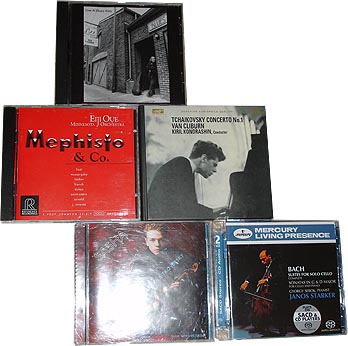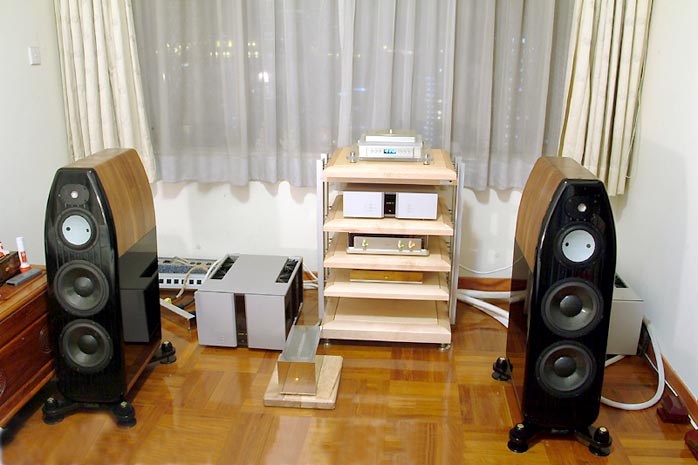|
This review page is supported in part by the sponsor whose ad is displayed above
|
||||||||||||||
 |
||||||||||||||
 |
||||||||||||||
Chikuma 75M-1400 With a price tag of ¥250,000 (USD 2,500), this was the most expensive AC bar of our comparison, its finish of the chassis also the most beautiful of the three. I applied the same test configuration as before. The scale of the soundstage immediately riveted my attention [Decca London Noye's Fludde Track 5]. It was very expansive on all fronts, albeit with a corresponding increase of image sizes. (Speaker positioning remained constant through all the comparisons.) The dynamic range between the highest and lowest points was obviously wider, with a slight bias of emphasis to the bottom octave. Delivery of mid-bass attack tended to be a bit less developed in turn. Bass energy seemed diverted to the floor rather than thrust at the listener. In terms of impact and resolution, the Chikuma produced more deep bass than the other two. The broad contours of the bass foundation in symphonic/orchestral settings was thus very well structured. In Pictures at an Exhibition [conducted by Fritz Reiner and the Chicago Symphony Orchestra on RCA Living Stereo, track number 8] my floor was virtually carpeted with bass energy. Musical objects within this expansive soundstage were presented with a good development of body. However, I found the overly silky and smooth midrange to mask certain textures and subtle variations. Though very soft and tender in texture, the sharp increase of midrange density seemed to draw the listener's attention to it. An interesting finding was the preservation of harmonic decay trails despite the beautifying enhancements of the vocal range, which in most similar cases of a highlighted midrange tends to crowd out harmonic fades. The treble was surely not of the glistening type but nevertheless fairly well extended before slowly fading out. When I listened to Mischa Elman's recording again, the size of the violin had puffed up to make it sounds more like a viola. I somewhat feel that the Chikuma exhibited a somewhat uneven character between different frequency regions. Due to the hefty price tag of this unit, I didn't want to draw hasty conclusions and as a result, I requested some expert assistance from Marvel to offer me and our readers a 2nd opinion on the 75M-1400. He uses Wilson Audio's Watt/Puppy 7 as his reference speaker and drives them with the same electronics as mine, wired up completely with the same SMR cables from digital all the way to the speaker cables. He also used the SMR power cord as the main AC cable feeding the Chikuma from the wall. |
||||||||||||||
 |
Chikuma 75M-1400 by Marvel On what otherwise would have been a perfectly peaceful Friday afternoon when I was all set for a long and relaxed weekend, I received an email from Linnman asking if I could help him procure a Japanese power distributing unit. I already knew that Linnman was in the process of examining different types of reference-class AC power distributors. That afternoon saw several more emails traded between Linnman and myself and within an hour of the first e-mail, I placed an order with one of my friends living in Tokyo to reserve a Chikuma 75M-1400 from a limited production run of 50 units for Linnman. The unit was couriered to Hong Kong and landed safely in my hands less than 72 hours later. Before even opening the box, my first impression was one of solidity, with a weight of at least 3kg. For a unit measuring 34cm x 9cm x 7cm and equipped with 4 Meikosha outlets, it clearly was constructed very seriously, with all the design discipline we so often see exhibited by the Japanese culture. I still remember Linnman's excitement over receiving this unit. I went to my office during lunch break and found him eating some dim sum in the kiosk inside the train station. Linnman never disappoints me with his relentless efforts and enormous interest in pursuing the best of hi-fi gear. |
|||||||||||||
 |
||||||||||||||
| Master of temptation, Linnman then sent me the Chikuma after it had spent a few weeks in his system. He requested I add a short review of this unit to form part of his recent research into various power distributors. According to Linnman, this would add objectivity to his findings by including commentary derived from a different system and by a different listener. Upon receipt, I was immediately attracted by the unit's 4 adjustable feet. When I started to turn the screws, I was startled by the smoothness and | ||||||||||||||
| quietness of the movement. It revealed a precision of execution unparalleled by any other tuning feet of competing units. It clearly measures up to the highest levels rivaling the Burmester reference gear I once used. For craftsmanship and ease of use, I would definitely classify this as Grade A+. Before its arrival, I was using an Argento Serenity Master Reference (SMR) power cord from an FIM wall duplex socket to a Japanese power distributor called AudioReplas SAA-6SZ [below]. Similar to the Chikuma, it uses neither filter nor any active components. It has 3 sets of duplex outlets housed in 3 compartments crafted from solid aluminum. From the AudioReplas, I connected 3 more Argento SMR power cords to my Orpheus The Zero Transport, Zanden 5000 Signature DAC and Vitus SL-100 preamp. I use a pair of Watt/Puppy System 7 speakers. For this comparison, I used the following CDs: Eva Cassidy Live at Blues Alley; Eva Cassidy Imagine; Helene Grimaud Credo; Perlman Cinema Serenade; Alexander Sitkovetsky Sasha; Janos Starker Bach Suites for Solo Cello; Mischa Maisky & Martha Argerich In Concert; Tchaikovsky Concerto No. 1 Van Cliburn [XRCD24]; Eiji Oue & Minnesota Orchestra Mephisto & Co; The Mask of Zorro. Over the week during which I seriously evaluated the Chikuma every night, I formed an initial impression of its performance in my system and crosschecked my findings with Linnman who had tested this unit for more than 3 weeks. My impressions on the Chikuma 75M-1400 power distributors are as follows: |
||||||||||||||
| Soundstage: It provided a neat layout of the soundstage by giving adequate space for each musical image. Compared to the AudioReplas, dimensionality and scale expanded a bit and also projected the stage slightly forward but certainly not to any extent that would create unease or undue pressure. When listening to Mischa Maisky/Martha Argerich In Concert, the sense of a solid and spacious musical stage became very vivid and unmistakable. |
 |
|||||||||||||
| Tonal Balance: I am particularly resistant and therefore sensitive to scratchy and harsh violin treble. When playing Perlman's Cinema Serenade Track 2 "Scent of a Woman" and Sasha, this unit produced the clarity of the strings with a silky touch to soften | ||||||||||||||
| the overall presentation to a noticeable extent compared to my AudioReplas. Having said that, the latter already isn't on the bright side but by comparison, the Chikuma was obviously on the subdued side of the treble department. In the mid-high to mid-low band, the performance of the Chikuma would be most attractive to vocal lovers as it really adds a lot of moisture and flesh to impress big time when playing Eva Cassidy's Imagine and Live At Blues Alley. On the other hand, when I played Starker's Bach Suites for Solo Cello, I could sense a slight inclination to roundness, leading to some loss of details, touch and skillfulness displayed by Starker. If I were to single out one key strength of this unit, I would no doubt place its bass performance at the top. Its bass structure and layering significantly added excitement factor to my listening sessions of Mephisto and Mask of Zorro where I could feel the tidal wave of the bass gathering from beneath my feet rather than feeling it forced into my face. Punches dove deep yet didn't scatter at the mid-bass juncture where many power cords and AC bars excel only to fail to go any lower and truly plumb the depths. Harmonic Structure and Details: When playing Credo's Track 1 "Fantasia" of the ostinato for solo piano, the lingering of the 1st, 2nd, 3rd and even 4th order harmonic decays could be heard loud and clear. Coherence and continuity of this harmonic decay was smooth and unbroken. Macro and Micro Dynamics: The Chikuma obviously lacked a bit of speed compared to the AudioReplas when it came to big slams and surges in grandiose orchestral works like Tchaikovsky's Piano Concerto No. 1. It behaved like a skilled and knowledgeable gentleman, light of touch with the flares and dynamite. Musicality and Tonality: With all the records I played using this unit, ambience and tonality of the instruments used were rich and subtle. Compared to the AR, the Chikuma tended to produce a warmer tonality particularly prominent in the midrange, thus giving it a slightly more distinguished and voiced signature than an otherwise neutral power bar would have one expect. Transparency and Clarity: On Credo's Track 1 and Sasha, the tonal picture remained crystal clear and with a more than satisfactory low noise floor. In conclusion, the Chikuma is undoubtedly a reference-class power distributor with a very good balance of tonality and frequency response. Bass performance in particular is remarkable and no doubt among the best of the power bars I have heard. Craftsmanship here has attained an unsurpassed level of excellence and the outlets provide very good surface contacts to ensure that current transfer isn't degraded when the components plugged in pull a sudden surge of power. Back to Linnmann: What did I learn? Some would argue that most filtering and conditioning devices and isolation transformers must perform better at silencing powerline noise to render better and blacker backgrounds. Alas, it is my subjective experience that such methods tend to compromise both micro and macro dynamics to varying degrees. Do not be misled by the simplicity of today's AC bars. Regardless of their variations in character, one common thread unites them: their excellent control of mechanical vibrations. The silence arising from the minimization of mechanical vibrations is very different from the annihilation of noise by other means such as active filtering in whatever guise. Music seems to flow more naturally without the common restraints of active devices. Passive units deliver more music to the listener via spontaneity and directness while perhaps not on the blackest of pitch-black backdrops. Active AC devices always tend to do better at rendering a blacker background, usually with slightly restrained micro transients and shorter extensions of harmonic decay trails but increased details due to an even lower noise floor. It's quite easy to tell the differences between these two approaches if one listens to disc 3, track 1 "Scarlatti: Sonata K. 38" from Horowitz' Complete Recordings on DGG. |
||||||||||||||
 |
||||||||||||||
|
|
||||||||||||||
 |
||||||||||||||
|
|
||||||||||||||
 |
||||||||||||||
 |
||||||||||||||
| Websites: Chikuma | Gryphon | Orb | ||||||||||||||
 |
||||||||||||||